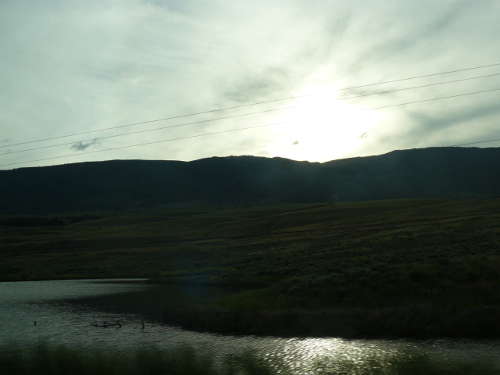 Location Taken: Eastern British Columbia
Location Taken: Eastern British Columbia
Time Taken: June 2010
In today’s edition of “Headlines to run away from really quickly”, we have the fabulous “Giant Hole Appears at World’s End“! I do suggest checking out the video as well. It’s quite a massive hole, so deep all you can see is darkness, the edges charred black and looking like something burst out from below.
Doesn’t that seem like a title you’d see on a newspaper “casually” shown to the audience at the start of a disaster movie? Or perhaps a news broadcast. That video would fit right in.
Sadly, we’re not too likely to suddenly face an apocalypse. It’s far more likely to be one of the weird phenomena of permafrost country.
Permafrost is an odd being. It’s simple in theory, just ground that happens to hang out below freezing for most of its existence. This brings in all sorts of odd events, though, thanks to the times when it’s not frozen. Even areas that have the air below freezing have a thin layer of ground thawing when exposed to sunlight. This is the only thing that allows plants to grow in these cold areas, even if it’s just grass that never grows more than a few inches tall. If the ground never thaws enough for plants, well, it tends to either not have much dirt at all (since dirt is produced by plants) and/or is covered in snow and ice, and thus doesn’t count as permafrost any more.
So, what does this little bit of thawing do? Allows water to move around, of course! And where water moves, so does everything it can drag along. To top it off, when night falls and the area grows cold once more, the water freezes and expands. These are some of the simplest cycles of the world as we know it, writ large across a landscape without much holding the dirt in place.
This process repeating day after day, year after year, leads to some very peculiar landforms appearing. Lakes appear all over, small hills rise up, as water moving to the lowest spot again and again, then freezing and pushing the dirt away is repeated over and over. Water gets trapped on the surface, unable to work its way through the permanent layer of ice down below where the sun’s heat is never felt. Patterned ground appears, strange regular polygons and circles and stripes where larger stones get shoved around by the moving ice. In especially wet areas, ice cores push soil up as large chunks of ice under the ground stay frozen during the day, have water seep under them, and float upwards. This forms either low palsas where the ice flattens out into a lens or tall pingos where it is forced to grow upwards instead.
Another odd feature of permafrost territory is how rich they are in natural gas and fossil fuels. The same ice that traps the water on the surface traps gas underground, and the cold temperatures keep the plants from decomposing before they can get trapped underground by the moving ground and ice, where they start the slow conversion into coals and oils. This is why climate change scientists are so worried about the permafrost melting, as it would mean all that trapped carbon can get free again.
So, what does this all have to do with the disaster movie hole they found in northern Russia? Well, there’s a few leading theories for why this hole appeared. One is that it’s a collapsed pingo. The ice core melted away, the water drained, and the dirt on top fell in. This happens occasionally, and the hole looks a lot like a sinkhole, another water-carved feature. Another theory is that it was caused by an underground gas bubble exploding. The way it looks like the dirt around it was flung outwards and the charred appearance of the ground lend credence to this one. No one’s at all sure at this point, though. It was discovered only recently, by workers from local gas companies surveying the area by helicopter. And it’s remote enough it will take a week or so to get scientists and their equipment out there.
Oh, and that “World’s End” thing? That’s what the name of the Yamal Peninsula this hole is on literally translates as. Probably because it’s rough terrain right on the edge of the arctic ocean, but why should we let that stop any wild theories?!
Who knows, maybe once those scientists arrive, they’ll get eaten by the aliens from the crashed spaceship that REALLY created the hole! And then the real fun starts!
